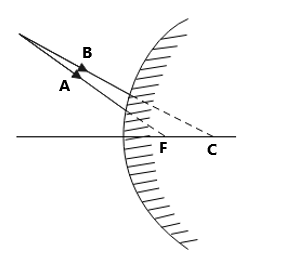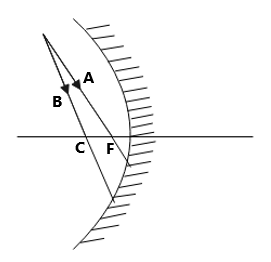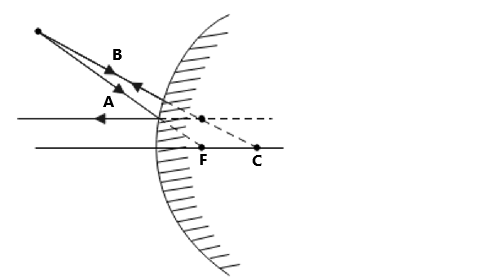
Complete the following diagrams by drawing the reflected ray for each of the incident ray A and B.




Answer
545.7k+ views
Hint:The two given diagrams are that of a convex mirror and a convex mirror respectively. Two rays are incident on each of the mirrors from the same direction but since the reflecting surfaces of the two mirrors are different, therefore, two different types of images are formed from both of them. This is due to the different properties of the reflecting surfaces.
Complete solution:
Convex mirror:
The incident ray A, when reflected from the surface of the convex mirror, reflects back parallel to the principal axis of the mirror. If we extend ray A behind the mirror, we find that the ray coincides with the focus of the mirror. The ray B is incident on the convex mirror such that it coincides with the center of curvature of the mirror. Hence, it retraces its path along the incident ray when reflected back from the surface of the mirror. The image formed is virtual and erect.

Concave mirror:
The incident ray A coincides with the principal focus of the concave mirror. Therefore, after reflection this ray travels parallel to the principal axis of the mirror. On the other hand, the ray incident ray B coincides with the center of curvature of the mirror, hence this reflected ray retraces its path back. The image formed is real and inverted.

Note:
In a concave mirror, as we bring the object closer to the mirror, the image formed gets enlarged and is also virtual. The nearer is the object to the reflecting surface, the bigger is the image formed. Due to this special property, the concave mirrors are used as shaving mirrors or make up mirrors to get the details of the face clearly.
Complete solution:
Convex mirror:
The incident ray A, when reflected from the surface of the convex mirror, reflects back parallel to the principal axis of the mirror. If we extend ray A behind the mirror, we find that the ray coincides with the focus of the mirror. The ray B is incident on the convex mirror such that it coincides with the center of curvature of the mirror. Hence, it retraces its path along the incident ray when reflected back from the surface of the mirror. The image formed is virtual and erect.

Concave mirror:
The incident ray A coincides with the principal focus of the concave mirror. Therefore, after reflection this ray travels parallel to the principal axis of the mirror. On the other hand, the ray incident ray B coincides with the center of curvature of the mirror, hence this reflected ray retraces its path back. The image formed is real and inverted.

Note:
In a concave mirror, as we bring the object closer to the mirror, the image formed gets enlarged and is also virtual. The nearer is the object to the reflecting surface, the bigger is the image formed. Due to this special property, the concave mirrors are used as shaving mirrors or make up mirrors to get the details of the face clearly.
Recently Updated Pages
A man running at a speed 5 ms is viewed in the side class 12 physics CBSE

The number of solutions in x in 02pi for which sqrt class 12 maths CBSE

State and explain Hardy Weinbergs Principle class 12 biology CBSE

Write any two methods of preparation of phenol Give class 12 chemistry CBSE

Which of the following statements is wrong a Amnion class 12 biology CBSE

Differentiate between action potential and resting class 12 biology CBSE

Trending doubts
What are the major means of transport Explain each class 12 social science CBSE

Which are the Top 10 Largest Countries of the World?

Draw a labelled sketch of the human eye class 12 physics CBSE

How much time does it take to bleed after eating p class 12 biology CBSE

Explain sex determination in humans with line diag class 12 biology CBSE

When was the first election held in India a 194748 class 12 sst CBSE




